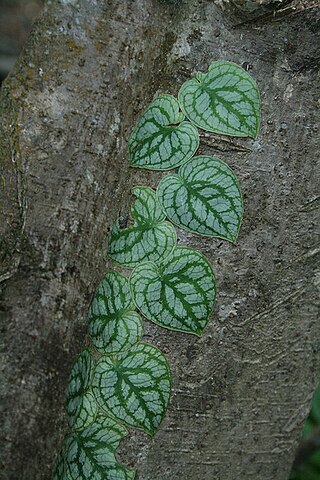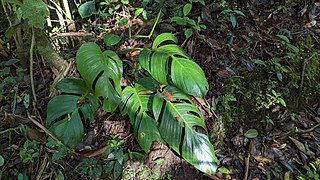
The Araceae are a family of monocotyledonous flowering plants in which flowers are borne on a type of inflorescence called a spadix. The spadix is usually accompanied by, and sometimes partially enclosed in, a spathe. Also known as the arum family, members are often colloquially known as aroids. This family of 140 genera and about 4,075 known species is most diverse in the New World tropics, although also distributed in the Old World tropics and northern temperate regions.

Monstera deliciosa, the Swiss cheese plant or split-leaf philodendron is a species of flowering plant native to tropical forests of southern Mexico, south to Panama. It has been introduced to many tropical areas, and has become a mildly invasive species in Hawaii, Seychelles, Ascension Island and the Society Islands. It is very widely grown in temperate zones as a houseplant.

Monstera is a genus of 59 species of flowering plants in the arum family, Araceae, native to tropical regions of the Americas.

Monstera adansonii, the Adanson's monstera, Swiss cheese plant, or five holes plant, is a species of flowering plant from family Araceae which is widespread across much of South America and Central America. Besides South American countries it can also be found in the West Indies on islands such as Antigua, Grenada, Saba, St. Kitts, Guadeloupe, Marie Galante, Dominica, Martinique, St. Lucia, St. Vincent, Tobago, and Trinidad. The species is quite common near river valleys at lower elevations.
Split-leaf philodendron is a common name for several plants in the Araceae family which may refer to:

Rhaphidophora tetrasperma, the mini monstera, is a species of flowering plant in the family Araceae, genus Rhaphidophora. It is native to Southern Thailand and to Malaysia.

Monstera acuminata, or shingle plant, is a species of flowering plant from family Araceae which is widespread from Mexico to Central America. It is abundant in central Petén and extends north to San Luis Potosí, making it the northernmost of the species of Monstera.

Monstera dubia is a species of plant in the genus Monstera native to Central and South America. M. dubia is known for the dramatic transformation its foliage makes as it climbs from seed stage on the forest floor, to shingling closely up a host tree trunk or other surface, until mature leaves with fenestrations similar to Monstera deliciosa appear. This transformation is an example of leaf dimorphism. Dubia refers to dubious, because authors were not certain that the species fell within the genus Marcgravia, where it was initially placed.

Monstera pinnatipartita is a species of flowering plant in the genus Monstera native to Central America and the tropical areas of South America. Like the more common Monstera deliciosa the plant has green foliage that becomes highly fenestrated when mature, though both immature and mature leaves are less heart shaped. Its name refers to the deeply split mature leaves that are pinnate.
Monstera amargalensis is a flowering plant that belongs to the genus Monstera, and the family Araceae.
Monstera cenepensis is a species of flowering plants in the family Araceae.
Monstera guzmanjacobiae is a species of plant in the family Araceae from Mexico.
Monstera integrifolia is a species of flowering plant in the genus Monstera in the arum family, Araceae.
Monstera juliusii is a flowering plant in the arum family (Araceae). It is native to high-altitude cloud forests of Costa Rica at altitudes of 1,600 to 2,250 metres and occasionally confused with Monstera standleyana. However, M. standleyana has green petioles, few fenestrations and thin leaves, while M. juliusii is characterized by mottled white petioles, frequent fenestrations at maturity and thick, leathery leaves. Mature plants have pinnatilobed leaves as long as 60 cm and 30 cm wide, with circular fenestrations close to the margins, and oval fenestrations near the midrib. The species is named after Julius Johnson, son of the artists Rashid Johnson and Sheree Hovsepian.
Monstera luteynii is a species of flowering plant in the genus Monstera of the arum family, Araceae.
Monstera maderaverde is a species of flowering plant in the genus Monstera in the arum family, Araceae. Its native range is Honduras.
Monstera minima is a species of flowering plant in the genus Monstera of the arum family, Araceae. Its binomial name minima refers to its tiny foliage, and it is indeed the smallest of the Monstera species when it comes to leaf size. It is most easily distinguished from other species in the genus due to the fact that its peduncles are much longer than its leaves.
Monstera molinae is a species of flowering plant in the genus Monstera in the arum family, Araceae.

Monstera monteverdensis is a species of flowering plant in the arum family, Araceae. Its adult form is characterized by pinnatifid margins with up to eight lobes per side, with occasional fenestrations away from the midrib. Leaves can grow as large as 60 cm long and 30 cm wide. It is named after the city of Monteverde, where the species is abundant.

Monstera tuberculata, also called the giant Monstera or the giant velvet-leaf Monstera, is a species of plant in the genus Monstera native from Mexico south to Panama. It grows in lowland wet tropical biomes up to 200 metres (660 ft) in elevation. Similar to Monstera dubia and a few other species in its genus, when young M. tuberculata has a shingle-like growth habit with leaves tightly pressed against the trunks of trees. As it matures, it has short-stemmed, oval leaves that lack the fenestrations of better-known species like Monstera deliciosa. Unusually for an aroid, its fruit hangs like a pendant.









